Fleurs du Mal Magazine


Or see the index
De Provincie West-Vlaanderen herdenkt van 2014 tot en met 2018 op culturele wijze 100 jaar Groote Oorlog. Deze eigentijdse, toekomstgerichte en multidisciplinaire herdenking kreeg de naam ‘GoneWest’.
GoneWest verbindt talloze levensverhalen met gedegen historisch besef en ontsluit deze kleine en grote verhalen via muziek-, dans-, theaterevenementen, literatuur en beeldende kunst.
“…because his brother had gone west, raved at the bleeding war; his rampant grief moaned, shouted, sobbed, and choked, while he was kneeling half-naked on the floor. In my belief such men have lost all patriotic feeling.” Siegfried Sassoon
 ‘To go west’, een Engelse uitdrukking, die zoveel betekent als sterven, kreeg tijdens de Eerste Wereldoorlog een bijkomende betekenis mee. Het ten westen gaan van de doden, met de ondergaande zon mee, werd aan het geallieerde front meer dan zomaar een metafoor. Britten, Fransen en Belgen bezetten dan ook het westelijke deel van dat Westelijke Front, dat van het noorden naar het zuiden West-Vlaanderen en Noord-Frankrijk doorsneed. Hun gesneuvelden en gekwetsten brachten ze daarmee letterlijk naar het westen toe.
‘To go west’, een Engelse uitdrukking, die zoveel betekent als sterven, kreeg tijdens de Eerste Wereldoorlog een bijkomende betekenis mee. Het ten westen gaan van de doden, met de ondergaande zon mee, werd aan het geallieerde front meer dan zomaar een metafoor. Britten, Fransen en Belgen bezetten dan ook het westelijke deel van dat Westelijke Front, dat van het noorden naar het zuiden West-Vlaanderen en Noord-Frankrijk doorsneed. Hun gesneuvelden en gekwetsten brachten ze daarmee letterlijk naar het westen toe.
Expo 600.000 beeldjes – 600.000 namen
Ervaar vanaf april 2018 de indrukwekkende land-artinstallatie ComingWorldRememberMe in het provinciedomein De Palingbeek in Ieper.
Deze installatie strekt zich uit over het niemandsland en The Bluff, een van de zwaarst bevochten plekken van de Eerste Wereldoorlog. De 600.000 beeldjes krijgen een plaats tussen drie grote kunstwerken van kunstenaar Koen Vanmechelen.
Tienduizenden mensen uit Vlaanderen en de rest van de wereld hielpen ComingWordRememberMe tot stand komen: samen maakten ze 600.000 beeldjes. Bij elk beeldje hoort een dog tag, het universele identificatiesysteem voor frontsoldaten. De dog tags combineren telkens de naam van een WOI-slachtoffer met de naam van een maker van een beeldje. Elke dog tag verbindt zo letterlijk het verleden met het heden.
Een doorzichtig werk van kunstenaar Koen Vanmechelen biedt plaats aan de 600.000 dog tags. De namen van de oorlogsslachtoffers komen uit ‘De Namenlijst’. Het In Flanders Fields Museum in Ieper stelde deze digitale lijst met alle slachtoffers van WOI in België samen.
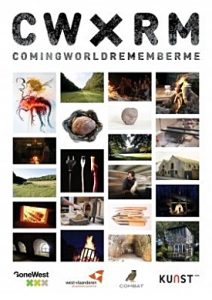
Het doorzichtige kunstwerk met de 600.000 dog tags krijgt een plaats in het paviljoen aan de start van het wandelparcours rond de land-artinstallatie. Het verenigt er letterlijk de verschillende nationaliteiten en generaties in de herdenking. Het engagement van al de betrokken mensen maakt van de land-art-installatie een grens- en generatie-overschrijdend symbool van vrede.
Tot eind mei 2018 kunt u bij uw bezoek aan het paviljoen een wandeling starten. Langs een deel van het wandeltraject hoort u op verschillende rustpunten oorlogspoëzie. De wandeling eindigt op de uitkijkbrug met een bijzonder uitzicht over de indrukwekkende land-artinstallatie.
Door het karakter van de locatie kan de volledige land-artinstallatie maar tijdelijk in het provinciaal domein De Palingbeek blijven staan. De dog-tags met de namen van oorlogsslachtoffers en peters en meters krijgen wel een definitieve plaats op het Niemandsland.
De organisatoren streven ernaar om de beeldjes na afloop van de expo op een respectvolle manier te verwijderen. Eind 2018 krijgen eerst alle peters en meters de kans om een beeldje uit de installatie op te halen. Voor de resterende beeldjes zoeken de initiatiefnemers een museale bestemming op verschillende locaties, zowel in België als in het buitenland.

Expo 600.000 beeldjes – 600.000 namen
Tot eind mei 2018
Koen Vanmechelen
Het oeuvre van kunstenaar Koen Vanmechelen is een voortdurende zoektocht naar de universele waarheid van ons bestaan. Met projecten als ‘The Cosmopolitan Chicken Project’, ‘The Open University of Diversity’ en ‘The Accident’, exploreert Koen Vanmechelen de terreinen van diversiteit en identiteit. Hij wordt hiervoor naar inhoud en verbeelding sinds jaren internationaal gerespecteerd. Het werk van Vanmechelen is een ode aan het leven en is bestemd voor de nieuwe kosmopolitische mens. Hij koestert culturele verschillen. Is ruimdenkend. Zoekt naar begrip van het andere. Leeft van constructieve confrontatie. Verlegt grenzen. Is uit op symbiose. Probeert de beladen begrippen ‘identiteit’ en ‘diversiteit’ te herdefiniëren in een wereld die ooit grenzeloos was en het ooit weer zal worden.Een filosofie die perfect aansluit bij het verhaal dat ComingWorldRememberMe wil vertellen dus.
Meer informatie op website: http://www.koenvanmechelen.be & https://www.gonewest.be/
GONEWEST: Artistieke herdenking 100 jaar Groote Oorlog in West-Vlaanderen
fleursdumal.nl magazine
More in: *War Poetry Archive, Art & Literature News, FDM Art Gallery, Galerie des Morts, Historia Belgica, Land Art, WAR & PEACE
 De Amsterdamse schrijver en dichter F.Starik (pseudoniem van Frank von der Möhlen) is vorige week vrijdag (16 maart 2018) overleden aan een hartstilstand. Hij was 59 jaar oud.
De Amsterdamse schrijver en dichter F.Starik (pseudoniem van Frank von der Möhlen) is vorige week vrijdag (16 maart 2018) overleden aan een hartstilstand. Hij was 59 jaar oud.
Starik schreef tien dichtbundels en was een van de dichters die bij toerbeurt in Amsterdam een speciaal geschreven gedicht voorlazen bij de uitvaart van eenzaam gestorven mensen.
Hij trad regelmatig op, op festivals als Oerol en Lowlands en literaire evenementen als De Nacht van de Poëzie en Crossing Border. Afgelopen zondag was zijn laatste optreden, op het internationale dichtersfestival StAnza, in Schotland.
F. Starik was stadsdichter van Amsterdam van 2010 tot 2012. Bij zijn afscheid als stadsdichter ontving hij van burgemeester Van der Laan het Ereteken van Verdienste.
# meer informatie over Starik is te vinden op de website van zijn uitgeverij Nieuw Amsterdam
fleursdumal.nl magazine
More in: Archive S-T, Archive S-T, Art & Literature News, Galerie des Morts, In Memoriam
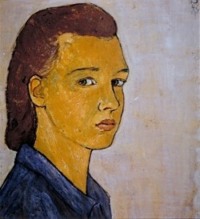 Het Joods Historisch Museum markeert het honderdste geboortejaar van kunstenares Charlotte Salomon (1917-1943) met een bijzondere tentoonstelling gewijd aan haar artistieke nalatenschap: het kunstwerk Leven? of Theater?
Het Joods Historisch Museum markeert het honderdste geboortejaar van kunstenares Charlotte Salomon (1917-1943) met een bijzondere tentoonstelling gewijd aan haar artistieke nalatenschap: het kunstwerk Leven? of Theater?
Charlotte Salomon was 22 jaar toen ze in december 1938 vanuit Berlijn als vluchteling bij haar grootouders in Zuid-Frankrijk aankwam. Toen bij het uitbreken van de Tweede Wereldoorlog haar grootmoeder zelfmoord pleegde, begon Charlotte aan een ‘totaal waanzinnig project’ om mentaal te overleven. In vele honderden gouaches herschiep ze haar leven als een geschilderd theaterstuk. Charlotte Salomon werd in 1943 in Auschwitz vermoord.
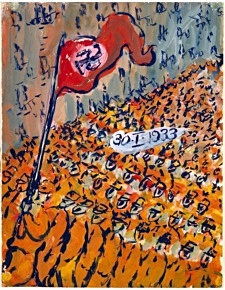 Na de Tweede Wereldoorlog vonden haar vader en zijn vrouw Leven? of Theater? in Zuid-Frankrijk. Zij schonken het in 1971 aan het Joods Historisch Museum. De afgelopen decennia reisden delen van het werk langs musea wereldwijd. Salomons levenswerk heeft altijd intense reacties opgeroepen bij het publiek en inspireerde kunstenaars, filmers, schrijvers en choreografen tot eigen creaties. Het Joods Historisch Museum toont nu voor het eerst het werk in zijn totaal – ruim 800 gouaches.
Na de Tweede Wereldoorlog vonden haar vader en zijn vrouw Leven? of Theater? in Zuid-Frankrijk. Zij schonken het in 1971 aan het Joods Historisch Museum. De afgelopen decennia reisden delen van het werk langs musea wereldwijd. Salomons levenswerk heeft altijd intense reacties opgeroepen bij het publiek en inspireerde kunstenaars, filmers, schrijvers en choreografen tot eigen creaties. Het Joods Historisch Museum toont nu voor het eerst het werk in zijn totaal – ruim 800 gouaches.
Charlotte Salomon;
Leven? of theater?
Nog t/m 25 maart 2018
Joods Historisch Museum en JHM Kindermuseum
Nieuwe Amstelstraat 1
1011 PL Amsterdam
# meer info op website joods historisch museum
fleursdumal.nl magazine
More in: - Book Stories, Art & Literature News, Charlotte Salomon, FDM Art Gallery, Galerie des Morts, Holocaust, REPRESSION OF WRITERS, JOURNALISTS & ARTISTS
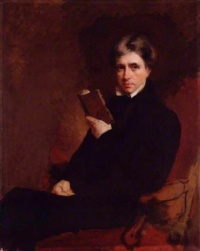 Deaths of Little Children
Deaths of Little Children
by Leigh Hunt
A Grecian philosopher being asked why he wept for the death of his son, since the sorrow was in vain, replied, “I weep on that account.” And his answer became his wisdom. It is only for sophists to contend that we, whose eyes contain the fountains of tears, need never give way to them. It would be unwise not to do so on some occasions. Sorrow unlocks them in her balmy moods. The first bursts may be bitter and overwhelming; but the soil on which they pour would be worse without them. They refresh the fever of the soul—the dry misery which parches the countenance into furrows, and renders us liable to our most terrible “flesh-quakes.”
There are sorrows, it is true, so great, that to give them some of the ordinary vents is to run a hazard of being overthrown. These we must rather strengthen ourselves to resist, or bow quietly and drily down, in order to let them pass over us, as the traveller does the wind of the desert. But where we feel that tears would relieve us, it is false philosophy to deny ourselves at least that first refreshment; and it is always false consolation to tell people that because they cannot help a thing, they are not to mind it. The true way is, to let them grapple with the unavoidable sorrow, and try to win it into gentleness by a reasonable yielding. There are griefs so gentle in their very nature that it would be worse than false heroism to refuse them a tear. Of this kind are the deaths of infants. Particular circumstances may render it more or less advisable to indulge in grief for the loss of a little child; but, in general, parents should be no more advised to repress their first tears on such an occasion, than to repress their smiles towards a child surviving, or to indulge in any other sympathy. It is an appeal to the same gentle tenderness; and such appeals are never made in vain. The end of them is an acquittal from the harsher bonds of affliction—from the typing down of the spirit to one melancholy idea.
It is the nature of tears of this kind, however strongly they may gush forth, to run into quiet waters at last. We cannot easily, for the whole course of our lives, think with pain of any good and kind person whom we have lost. It is the divine nature of their qualities to conquer pain and death itself; to turn the memory of them into pleasure; to survive with a placid aspect in our imaginations. We are writing at this moment just opposite a spot which contains the grave of one inexpressibly dear to us. We see from our window the trees about it, and the church spire. The green fields lie around. The clouds are travelling overhead, alternately taking away the sunshine and restoring it. The vernal winds, piping of the flowery summer-time, are nevertheless calling to mind the far-distant and dangerous ocean, which the heart that lies in that grave had many reasons to think of. And yet the sight of this spot does not give us pain. So far from it, it is the existence of that grave which doubles every charm of the spot; which links the pleasures of our childhood and manhood together; which puts a hushing tenderness in the winds, and a patient joy upon the landscape; which seems to unite heaven and earth, mortality and immortality, the grass of the tomb and the grass of the green field; and gives a more maternal aspect to the whole kindness of nature. It does not hinder gaiety itself. Happiness was what its tenant, through all her troubles, would have diffused. To diffuse happiness, and to enjoy it, is not only carrying on her wishes, but realising her hopes; and gaiety, freed from its only pollutions, malignity and want of sympathy, is but a child playing about the knees of its mother.
The remembered innocence and endearments of a child stand us instead of virtues that have died older. Children have not exercised the voluntary offices of friendship; they have not chosen to be kind and good to us; nor stood by us, from conscious will, in the hour of adversity. But they have shared their pleasures and pains with us as well as they could; the interchange of good offices between us has, of necessity, been less mingled with the troubles of the world; the sorrow arising from their death is the only one which we can associate with their memories. These are happy thoughts that cannot die. Our loss may always render them pensive; but they will not always be painful. It is a part of the benignity of Nature that pain does not survive like pleasure, at any time, much less where the cause of it is an innocent one. The smile will remain reflected by memory, as the moon reflects the light upon us when the sun has gone into heaven.
When writers like ourselves quarrel with earthly pain (we mean writers of the same intentions, without implying, of course, anything about abilities or otherwise), they are misunderstood if they are supposed to quarrel with pains of every sort. This would be idle and effeminate. They do not pretend, indeed, that humanity might not wish, if it could, to be entirely free from pain; for it endeavours, at all times, to turn pain into pleasure: or at least to set off the one with the other, to make the former a zest and the latter a refreshment. The most unaffected dignity of suffering does this, and, if wise, acknowledges it. The greatest benevolence towards others, the most unselfish relish of their pleasures, even at its own expense, does but look to increasing the general stock of happiness, though content, if it could, to have its identity swallowed up in that splendid contemplation. We are far from meaning that this is to be called selfishness. We are far, indeed, from thinking so, or of so confounding words. But neither is it to be called pain when most unselfish, if disinterestedness by truly understood. The pain that is in it softens into pleasure, as the darker hue of the rainbow melts into the brighter. Yet even if a harsher line is to be drawn between the pain and pleasure of the most unselfish mind (and ill-health, for instance, may draw it), we should not quarrel with it if it contributed to the general mass of comfort, and were of a nature which general kindliness could not avoid. Made as we are, there are certain pains without which it would be difficult to conceive certain great and overbalancing pleasures. We may conceive it possible for beings to be made entirely happy; but in our composition something of pain seems to be a necessary ingredient, in order that the materials may turn to as fine account as possible, though our clay, in the course of ages and experience, may be refined more and more. We may get rid of the worst earth, though not of earth itself.
Now the liability to the loss of children—or rather what renders us sensible of it, the occasional loss itself—seems to be one of these necessary bitters thrown into the cup of humanity. We do not mean that every one must lose one of his children in order to enjoy the rest; or that every individual loss afflicts us in the same proportion. We allude to the deaths of infants in general. These might be as few as we could render them. But if none at all ever took place, we should regard every little child as a man or woman secured; and it will easily be conceived what a world of endearing cares and hopes this security would endanger. The very idea of infancy would lose its continuity with us. Girls and boys would be future men and women, not present children. They would have attained their full growth in our imaginations, and might as well have been men and women at once. On the other hand, those who have lost an infant, are never, as it were, without an infant child. They are the only persons who, in one sense, retain it always, and they furnish their neighbours with the same idea. The other children grow up to manhood and womanhood, and suffer all the changes of mortality. This one alone is rendered an immortal child. Death has arrested it with his kindly harshness, and blessed it into an eternal image of youth and innocence.
Of such as these are the pleasantest shapes that visit our fancy and our hopes. They are the ever-smiling emblems of joy; the prettiest pages that wait upon imagination. Lastly, “Of these are the kingdom of heaven.” Wherever there is a province of that benevolent and all-accessible empire, whether on earth or elsewhere, such are the gentle spirits that must inhabit it. To such simplicity, or the resemblance of it, must they come. Such must be the ready confidence of their hearts and creativeness of their fancy. And so ignorant must they be of the “knowledge of good and evil,” losing their discernment of that self-created trouble, by enjoying the garden before them, and not being ashamed of what is kindly and innocent.
Deaths of Little Children
by Leigh Hunt (1784 – 1859)
fleursdumal.nl magazine
More in: Archive G-H, Archive G-H, Galerie des Morts, Hunt, Leigh
What is the price of poetry? An examination of how the deaths of great poets have shaped our culture’s distorted sense of poetry.
 From Chatterton’s Pre-Raphaelite demise to Keats’ death warrant in a smudge of arterial blood; from Dylan Thomas’s eighteen straight whiskies to Sylvia Plath’s desperate suicide in the gas oven of her Primrose Hill kitchen or John Berryman’s leap from a bridge onto the frozen Mississippi, the deaths of poets have often cast a backward shadow on their work.
From Chatterton’s Pre-Raphaelite demise to Keats’ death warrant in a smudge of arterial blood; from Dylan Thomas’s eighteen straight whiskies to Sylvia Plath’s desperate suicide in the gas oven of her Primrose Hill kitchen or John Berryman’s leap from a bridge onto the frozen Mississippi, the deaths of poets have often cast a backward shadow on their work.
The post-Romantic myth of the dissolute drunken poet – exemplified by Thomas and made iconic by his death in New York – has fatally skewed the image of poets in our culture. Novelists can be stable, savvy, politically adept and in control, but poets should be melancholic, doomed and self-destructive. Is this just a myth, or is there some essential truth behind it: that great poems only come when a poet’s life is pushed right to an emotional knife-edge of acceptability, safety, security? What is the price of poetry? In this book, two contemporary poets undertake a series of journeys – across Britain, America and Europe – to the death places of poets of the past, in part as pilgrims, honouring inspirational writers, but also as investigators, interrogating the myth. The result is a book that is, in turn, enlightening and provocative, eye-wateringly funny and powerfully moving.
Michael Symmons Roberts‘s sixth collection of poetry, Drysalter, was the winner of both the Forward Prize and the Costa Poetry Prize in 2013. He has published two novels, and is Professor of Poetry at Manchester Metropolitan University.
Paul Farley is the author of four collections of poetry and has won the Forward Prize for Best First Collection, the Whitbread Poetry Award and the E. M. Forster Award.
Edgelands, co-written with Michael Symmons Roberts, received the Royal Society of Literature’s Jerwood Award and the 2011 Foyles Best Book of Ideas Award and was serialised as Radio 4 Book of the Week.
The Deaths of the Poets
Michael Symmons Roberts & Paul Farley
ISBN : 9780224097543
Hardback, 400 pages
February 2017
Publisher: Random House Children’s Publishers UK
fleursdumal.nl magazine
More in: - Archive Tombeau de la jeunesse, - Book News, Art & Literature News, DEAD POETS CORNER, Galerie des Morts, POETRY ARCHIVE, Sylvia Plath
 De laatste deur (nieuwe herziene en zeer uitgebreide editie)
De laatste deur (nieuwe herziene en zeer uitgebreide editie)
door Jeroen Brouwers
Liefde-literatuur-dood is de thematische drie-eenheid binnen het oeuvre van Jeroen Brouwers. Zijn fascinatie voor zelfmoord dateert van het begin van de jaren zeventig, toen een vriendin zich het leven had benomen. Brouwers’ wens om het zelfmoordraadsel te begrijpen resulteerde in het inmiddels legendarische boek De laatste deur.
Dit is de ingrijpend herziene en zeer uitgebreide editie van het dertig jaar geleden verschenen werk, dat handelt over de zelfverkozen dood van Nederlandstalige schrijvers. Vanuit gevoelens van mededogen, begrip en solidariteit met hen die in het verleden en de meer recente tijd de hand aan zichzelf sloegen (van wie hij er enkelen van zeer nabij heeft gekend), poogt Brouwers aan de hand van hun literaire werk een mogelijke verklaring te vinden voor hun ultieme daad.
Brouwers karakteriseert op integere en invoelende wijze uiteenlopende figuren als François Haverschmidt (Piet Paaltjens), Menno ter Braak, Halbo Kool, Jan Emmens, Jan Arends, Dirk de Witte, Jan Emiel Daele, Jotie T’Hooft en tal van anderen. Deze nieuwe editie bevat ook levensgeschiedenissen van overledenen in de laatste jaren: Adriaan Venema, Anil Ramdas, Nanne Tepper, Joost Zwagerman en Wim Brands.
Aan De laatste deur is een supplement toegevoegd (De zwarte zon, De versierde dood en verspreide opstellen) met essays over buitenlandse schrijvers en onderwerpen als zelfmoordverenigingen en –sekten, en geruchten en verzinsels over zelfmoord. Een aantal van deze opstellen is niet eerder in boekvorm verschenen.
Auteur(s) : Jeroen Brouwers
Uitgeverij : Atlas Contact
ISBN : 9789045021089
Taal : Nederlands
Uitvoering : Hardcover
Aantal pagina’s : 1400
Verschijningsdatum : 15-03-2017
Afmetingen : 314 x 254 x 27 mm.
Gewicht : 700 gr.
fleursdumal.nl magazine
More in: - Archive Tombeau de la jeunesse, - Book News, Art & Literature News, Babylon, Frans, Brands, Wim, DRUGS & DISEASE & MEDICINE & LITERATURE, Galerie des Morts, Jeroen Brouwers, Zwagerman, Joost
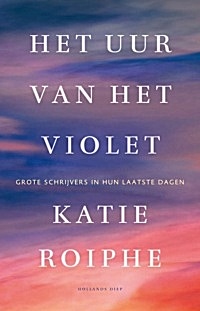 Eén van de scherpzinnigste en opvallendste hedendaagse auteurs doet na diepgaand onderzoek verslag van de laatste levensdagen van Susan Sontag, Sigmund Freud, John Updike, Dylan Thomas, Maurice Sendak en James Salter. Het levert een aantal fascinerende en uiterst originele overwegingen op over de eindigheid van het leven.
Eén van de scherpzinnigste en opvallendste hedendaagse auteurs doet na diepgaand onderzoek verslag van de laatste levensdagen van Susan Sontag, Sigmund Freud, John Updike, Dylan Thomas, Maurice Sendak en James Salter. Het levert een aantal fascinerende en uiterst originele overwegingen op over de eindigheid van het leven.
In Het uur van het violet kiest Katie Roiphe voor een onverwachte en bevrijdende benadering van een onderwerp waar niemand omheen kan. Ze gaat na hoe de laatste levensdagen waren van zes grote denkers, schrijvers en kunstenaars en hoe zij omgingen met de realiteit van de naderende dood, of, zoals T.S. Eliot het noemde: ‘het avondlijk uur dat Huiswaarts gericht is en de zeeman thuisbrengt’.
We maken kennis met Susan Sontag, die, wanneer ze voor de derde keer de strijd tegen kanker aangaat, worstelt met haar engagement met het rationele denken. Roiphe neemt ons mee naar de kamer in het ziekenhuis waar de 76-jarige John Updike, nadat hem de slechtst mogelijke diagnose is meegedeeld, een gedicht begint te schrijven. Ze schept een levendig beeld van de twee weken durende, bijna suïcidaal overmatige inspanning die culmineerde in de totale instorting van Dylan Thomas in het Chelsea Hotel. Ze schetst voor ons een moedgevend portret van Sigmund Freud die, nadat hij het door de nazi’s bezette Wenen is ontvlucht, in zijn Londense ballingschap het dwangmatige roken van sigaren voortzet waarvan hij weet dat het zijn aftakeling zal verhaasten. En ze toont ons dat Maurice Sendaks geliefde kinderboeken doordesemd zijn van het feit dat hij zijn leven lang geobsedeerd was door de dood, al was dat niet altijd evident.
Het uur van het violet staat vol met intieme en verrassende onthullingen. In de laatste daden van al deze creatieve genieën worden we geconfronteerd met moed, passie, zelfbedrog, zinloos lijden en onovertroffen toewijding. Door de laatste levensdagen van deze grote auteurs te beschrijven in indrukwekkende, niet-sentimentele termen helpt Katie Roiphe ons om de dood moedig onder ogen te zien en er minder bang voor te zijn.
Katie Roiphe
Het uur van het violet
Grote schrijvers in hun laatste dagen
Vertaald uit het Engels door Anne Jongeling
Uitg. Hollands Diep
Paperback, 352 p.
ISBN: 9789048836420
€ 19.99 – Januari 2017
# Meer informatie op website Hollands Diep
fleursdumal.nl magazine
More in: - Book News, Art & Literature News, DEAD POETS CORNER, DICTIONARY OF IDEAS, Galerie des Morts, Susan Sontag, Thomas, Dylan, TOMBEAU DE LA JEUNESSE - early death: writers, poets & artists who died young
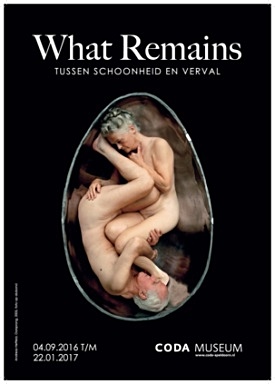
What Remains – tussen schoonheid en verval
04.09.2016 t/m 22.01.2017
De frictie tussen schoonheid en verval is door de eeuwen heen steeds weer in de kunst verbeeld. Uiteenlopende genres zoals het vanitasstilleven, het ‘schuldige’ landschap en het portret ontlenen hun aantrekkingskracht aan de ervaring van schoonheid in verval. Gastcurator Wim van der Beek maakte met het werk van 15 kunstenaars in opdracht van CODA directeur Carin Reinders een prikkelende en gevarieerde tentoonstelling die uiteenlopen aspecten van verval zichtbaar maakt.
De esthetiek van afval versus de grenzen van de consumptiemaatschappij, het hoopgevende zicht op nieuwe kansen of levensverlenging, de daklozenproblematiek; het is allemaal onlosmakelijk verbonden met de manier waarop we in de huidige samenleving omgaan met dat wat oud en versleten is of in de marge van de samenleving terechtgekomen is. De moderne samenleving worstelt met allerlei processen die samenhangen met de eindigheid van het leven en de periode van verval die daar aan voorafgaat. Beeldende kunstenaars confronteren de samenleving door andere perspectieven aan te reiken. Zij laten zien dat in verval ook schoonheid kan schuilen of ze vergroten het verval zo uit dat de confrontatie schrijnend en hard is. Een breed spectrum aan emoties wordt betrokken in het beeldvormingsproces: berusting, woede, angst, vertwijfeling, melancholie, weemoed en de worsteling met het besef van eindigheid.
De paradox van kunst en verval. What Remains maakt uiteenlopende aspecten van verval zichtbaar. Fysiek, mentaal, moreel, materieel, maatschappelijk, landschappelijk en architectonisch verval, veroudering en ouderdom, afval en hergebruik, natuurlijke afbraakprocessen, afgedankte voorwerpen en in de vergetelheid geraakte betekenissen en technieken komen in deze tentoonstelling aan de orde. De tentoonstelling in CODA Museum toont daarnaast dat beeldende kunst waarin vormen van verval gesublimeerd en vereeuwigd worden, verder gaat dan verval op zich. Hier doet zich namelijk een merkwaardige paradox voor: kunst waarin verval onderwerp is, kan eeuwigheidswaarde krijgen en ontworstelt zich daarmee aan de vergankelijkheid die de basis van het kunstwerk vormt. Wie bovendien verder kijkt dan het verval, kan schoonheid ontdekken en rust vinden. De bezoeker van What Remains kan echter niet om de dilemma’s heen die met verval en vergankelijkheid te maken hebben. Het besef dat er een rustgevende schoonheid kan uitgaan van verval biedt in elk geval een hoopgevend perspectief.
Deelnemende kunstenaars: Hugo Tieleman, Chris Jordan, Andreas Hetfeld, Ivo Kamphuis, Jan Eric Visser, Jehoshua Rozenman, Nicolas Dings, Jan Banning, Frans Beerens, Martine Feipel & Jean Bechameil, Yves Marchand & Romain Meffre, Ken’ichiro Taniguchi, Hans Op de Beeck, Sébastien van Malleghem.
CODA Bibliotheek
CODA Museum
CODA Archief & Kenniscentrum
Vosselmanstraat 299
7311 CL Apeldoorn
tel.: (055) 5268400
fleursdumal.nl magazine
More in: Art & Literature News, DICTIONARY OF IDEAS, Exhibition Archive, Galerie des Morts
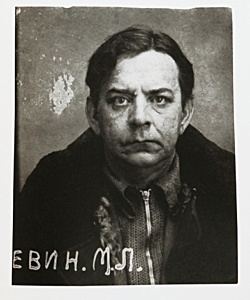 Het Nederlands Fotomuseum presenteert in het voorjaar van 2016 de tentoonstelling Crime Scenes | Honderd jaar foto als bewijs (t.m. 21 Aug. 2016)
Het Nederlands Fotomuseum presenteert in het voorjaar van 2016 de tentoonstelling Crime Scenes | Honderd jaar foto als bewijs (t.m. 21 Aug. 2016)
Kan een foto iets aantonen, bewijzen of onthullen? Al sinds de uitvinding van de fotografie wordt de fotocamera gezien als een vooral mechanisch instrument om de werkelijkheid af te beelden. Wat op een foto is te zien, is ooit zo geweest. Maar is wat op een foto staat daarom ook ‘waar’?
Foto’s kunnen ook een subjectief beeld van de werkelijkheid geven en ze kunnen zijn gemanipuleerd of in scène gezet. De fascinerende wijze waarop foto’s in de afgelopen 150 jaar in rechtszaken zijn gebruikt, en de discussies die er over fotografie werden gevoerd, brengt Crime Scenes voor het eerst in kaart.
Crime Scenes presenteert elf case studies uit de geschiedenis van de ‘foto als bewijsstuk’, met de nadruk op zaken van groot humanitair en/of volkenrechtelijk belang: van begin 1900 tot aan vandaag. Beginnend met de beroemde crime scene foto’s van de Franse politiefotograaf Alphonse Bertillion, via de luchtfoto’s van gebombardeerde steden tijdens de Eerste Wereldoorlog en de films van de concentratiekampen in de Neurenberger processen tegen de Nazi’s, eindigt de tentoonstelling met de problematiek rond de bewijsvoering van drone-aanslagen in Waziristan en de pogingen om aan te tonen dat de Bedouïnen in de Negev woestijn in vroeger tijden niet louter nomaden waren – met als inzet hun claim om er ook vandaag nog te mogen wonen. De tentoonstelling brengt een grote variatie aan historisch beeldmateriaal bijeen. De context van iedere casus wordt daarbij helder uiteengezet.
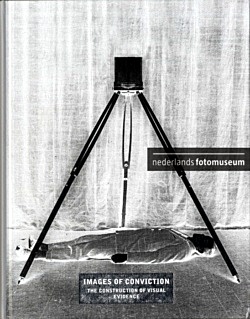 Nieuwe boekuitgave:
Nieuwe boekuitgave:
Images of conviction.
The construction of visual evidence
Photography Catalogue of the Year, winner of the 2015 Paris Photo-Aperture Foundation Photobook Awards
Each of these eleven case studies spanning the period from the invention of ‘metric’ photography of crime scenes in the nineteenth century to the reconstruction of a drone attack in Pakistan in 2012, offers an ‘archaeological’ analysis of the historical and geopolitical context in which the images appeared, as well as their purpose, the way they were produced and the specific framework of their reception.
The nature and the gravity of the facts described mean that no fallacious comparison must be allowed to simplify or reduce the ambit of such images. Coming not long after the invention of the medium, everyday use of photographs in the courtroom made the image’s power as truth an essential tool of conviction in the service of justice. This power as truth has been ardently debated, sometimes legitimately contested and often contradicted.
How does the image take shape in truth-seeking scientific and historical discourse?
Tekst: Jennifer L. Mnookin, Anthony Petiteau, Tomasz Kizny, Thomas Keenan, and Eric Stover
Aantal pagina’s: 240
Foto’s: 280 zwart wit foto’s
Formaat: 22 x 28.5 cm (staand)
Hardcover, € 44,95
Taal: Engels
Uitgever: Éditions Xavier Barral
ISBN: 9782365110839
Nederlands Fotomuseum
Gebouw Las Palmas
Wilhelminakade 332
3072 AR Rotterdam
# Meer info website Nederlands Fotomuseum
fleursdumal.nl magazine
More in: - Book News, Art & Literature News, CRIME & PUNISHMENT, Galerie des Morts, Photography
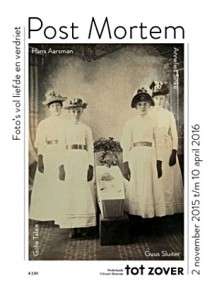 Foto’s gemaakt van overledenen roepen al ruim anderhalve eeuw afgrijzen en ontroering op. Uitvaartmuseum Tot Zover heeft vanaf 2 november een expositie over deze opmerkelijke traditie. ‘Post Mortem – foto’s vol liefde en verdriet’ bevat 185 historische post-mortemfoto’s uit de grootste Europese collectie met dit onderwerp, die van de Britse verzamelaar Paul Frecker. Het is de eerste keer dat zijn collectie wordt getoond. ‘Post Mortem’ toont ook moderne post-mortemfoto’s. Bovendien roept het museum iedereen op zelfgemaakte foto’s op te sturen.
Foto’s gemaakt van overledenen roepen al ruim anderhalve eeuw afgrijzen en ontroering op. Uitvaartmuseum Tot Zover heeft vanaf 2 november een expositie over deze opmerkelijke traditie. ‘Post Mortem – foto’s vol liefde en verdriet’ bevat 185 historische post-mortemfoto’s uit de grootste Europese collectie met dit onderwerp, die van de Britse verzamelaar Paul Frecker. Het is de eerste keer dat zijn collectie wordt getoond. ‘Post Mortem’ toont ook moderne post-mortemfoto’s. Bovendien roept het museum iedereen op zelfgemaakte foto’s op te sturen.
Foto’s van na het overlijden zijn meestal bestemd voor privégebruik en je ziet ze zelden in musea. Freckers collectie doodsportretten is de grootste van Europa en een van de grootste ter wereld. Museum Tot Zover slaagde er in het belangrijkste deel van zijn collectie naar Nederland te halen. De meeste foto’s uit deze unieke collectie stammen uit de periode 1860-1920. Twee derde bestaat uit foto’s van kinderen. De kindersterfte was hoog en vaak was dit de enige foto die men van het kind had. Het zijn bijzondere foto’s die een inkijkje geven in het gevoelsleven van onze voorouders.
‘Post Mortem’ laat ook foto’s zijn die de laatste jaren door uitvaartfotografen zijn gemaakt. Zij zetten een oude traditie voort met prachtige, ontroerende foto’s. Van kunstenaar Margriet Luyten zijn bovendien twee foto’s uit haar serie ‘Insomnia’ te zien; een daarvan is een bewerking van een foto uit de Frecker-collectie. Post-mortemfoto’s tonen een intiem soort verdriet en soms is het ook schrikken, een dode op de foto. Maar de foto’s zijn gemaakt uit liefde voor iemand, ze zijn een warme herinnering en een vastlegging van een moment dat niet vergeten mag worden.
 Dankzij de smartphone hebben we dagelijks een camera op zak en zijn we gewend alles wat we doen vast te leggen. Tijdens opbaringen en uitvaarten wordt er druk gefotografeerd. Zo belandt ook de post-mortemfotografie in een nieuwe fase. Museum Tot Zover roept op om foto’s naar het museum te sturen. Ze worden dan geprint en opgehangen. Zelf een foto meenemen en ophangen mag ook.
Dankzij de smartphone hebben we dagelijks een camera op zak en zijn we gewend alles wat we doen vast te leggen. Tijdens opbaringen en uitvaarten wordt er druk gefotografeerd. Zo belandt ook de post-mortemfotografie in een nieuwe fase. Museum Tot Zover roept op om foto’s naar het museum te sturen. Ze worden dan geprint en opgehangen. Zelf een foto meenemen en ophangen mag ook.
‘Post Mortem – foto’s vol liefde en verdriet’ wordt financieel mogelijk gemaakt door het Mondriaan Fonds, het VSBfonds en het Prins Bernhard Cultuurfonds. De audiotour is ingesproken door fotodetective Hans Aarsman, Frits Gierstberg (Nederlands Fotomuseum) en Hripsimé Visser (Stedelijk Museum). De expositie is te zien van 2 november 2015 t/m 10 april 2016.
Post Mortem
Foto's vol liefde en verdriet
Museum Tot Zover is gevestigd op begraafplaats, crematorium en gedenkpark De Nieuwe Ooster.
Kruislaan 124 – 1097 GA Amsterdam – tel. 020-6940482
Openingstijden: Dinsdag t/m zondag 11.00 – 17.00 uur. Het museum is gesloten op 1 januari, 27 april en 25 december. Op 26 en 31 december is het museum geopend van 11.00 – 15.00 uur. Café Roosenburgh is iedere dag open van 10.00 tot 17.00 uur, met uitzondering van 27 april. Op 25 en 26 december en op 1 januari is het café open van 11.00 – 15.00 uur. Op 31 december is het café geopend van 10.00 tot 15.30 uur.
# meer info website museum tot zover
fleursdumal.nl magazine
More in: Art & Literature News, Exhibition Archive, Galerie des Morts, In Memoriam, Photography, TOMBEAU DE LA JEUNESSE - early death: writers, poets & artists who died young
![]() Een indrukwekkend en tegelijkertijd confronterend tijdsdocument, waarin de pijnlijke gevolgen van de economische crisis, die sinds 2008 de wereld in zijn greep houdt, zijn opgetekend.
Een indrukwekkend en tegelijkertijd confronterend tijdsdocument, waarin de pijnlijke gevolgen van de economische crisis, die sinds 2008 de wereld in zijn greep houdt, zijn opgetekend.
Door de ogen van grafisch ontwerper Richard Sluijs – bij aanvang nog een relatieve buitenstaander in een land dat de dans leek te ontspringen – wordt het persoonlijke leed dat velen trof op monumentale wijze in beeld gebracht. Een verzameling verhalen van mensen die hun ellende niet langer konden verdragen, en zelfmoord als enige uitweg uit hun problemen zagen.
Het boek is een in memoriam voor alle slachtoffers van de crisis, en tegelijkertijd vormt het een kritisch tegengeluid voor de boodschap die politici, bankiers en economen propageren dat het strenge bezuinigingsbeleid zijn vruchten begint af te werpen en alles weldra weer bij het oude zal zijn. Want dat voor vele nabestaanden het leven nooit meer hetzelfde zal zijn, werd helaas ook voor de schrijver de trieste realiteit toen het boek na 6 jaar research bijna gereed was.
![]()
THE COMPLETE LEXICON OF CRISIS RELATED SUICIDES 2008-2013 VOLUME 1
Auteur: Richard Sluijs
Jaartal: 2014-11-20
Afmetingen: 15,5 x 24,5 cm, 6 cm dik
Pagina’s: 712 pagina’s met witte bedrukking
ISBN: 978-94-91525-37-7
Uitvoering: Hardcover, rood linnen, genaaid gebrocheerd, zwart op snee, zwart leeslint
NUR: 740
34,- EURO
Uitgeverij: d’jonge Hond / Komma
fleursdumal.nl magazine
More in: - Book News, Art & Literature News, Galerie des Morts, Suicide
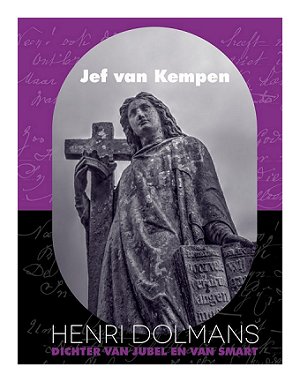
Op 31 augustus 2014, ter gelegenheid van de 17de editie van Boeken Rond Het Paleis in Tilburg, verschijnt voor het eerst een bundel over de dichter Henri Dolmans (1840-1899)
In dit boek beschrijft auteur en dichter Jef van Kempen het leven en werk van deze Tilburgse dichter, een markante ‘minor poet’ die de negentiende eeuw kleur gaf met zijn vele honderden funeraire gedichten. Henri Dolmans luisterde met de voordracht van zijn op maat geschreven dichtwerk menig begrafenis op, en schreef letterlijk tot aan zijn eigen sterfbed over het onderwerp de dood. Hij werd namelijk op zijn sterfbed gevonden met zijn laatst geschreven gedicht nog in de hand. Het bleek zijn eigen grafgedicht te zijn. Naast een beknopte biografie van Dolmans heeft Jef van Kempen een selectie gemaakt van de vele gedichten die Henri Dolmans heeft nagelaten, zowel van zijn post mortemgedichten als van zijn religieuze en herdenkingsgedichten.
Het Boek met de titel: ‘Henri Dolmans, dichter van jubel en van smart’ is een uitgave van Stichting Cools die werd verzorgd door uitgeverij Art Brut en is verkrijgbaar via de boekhandel.
Jef van Kempen,
Henri Dolmans, dichter van jubel en van smart
Uitgeverij Art Brut 2014
ISBN: 978-90-76326-07-8
(64 p. – geïllustreerd – prijs 10,00 euro)
fleursdumal.nl magazine
More in: - Book News, Art & Literature News, Galerie des Morts, Henri Dolmans, Jef van Kempen
Thank you for reading Fleurs du Mal - magazine for art & literature